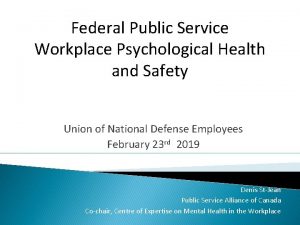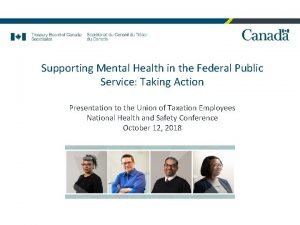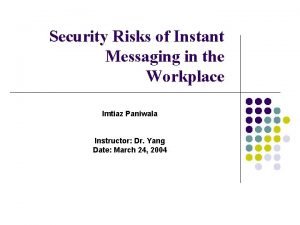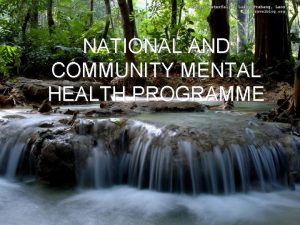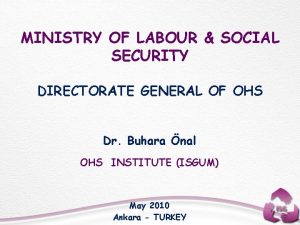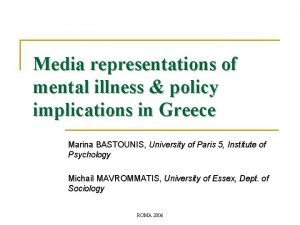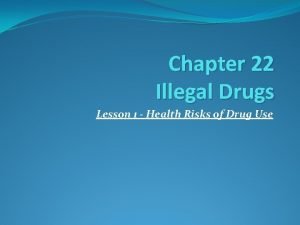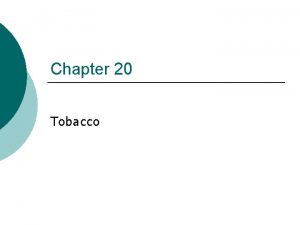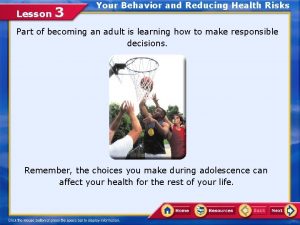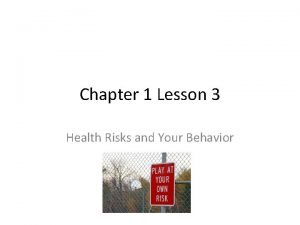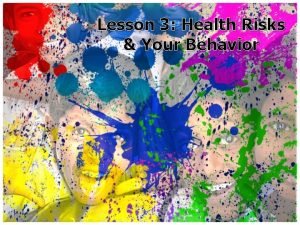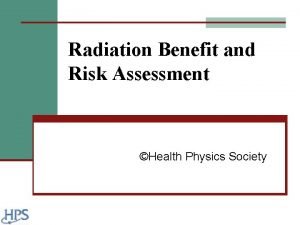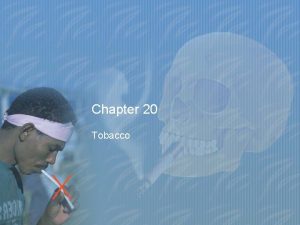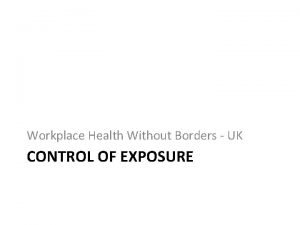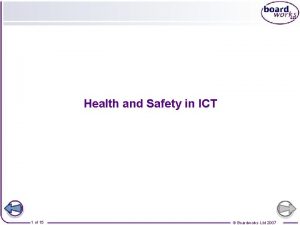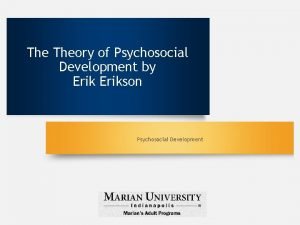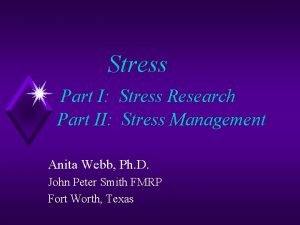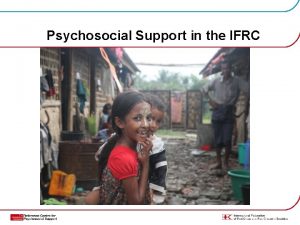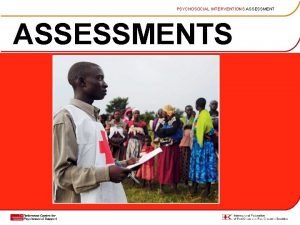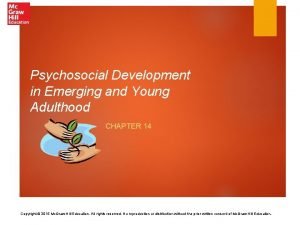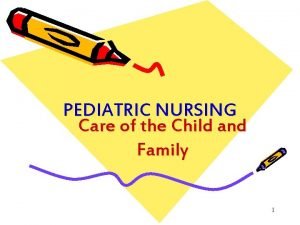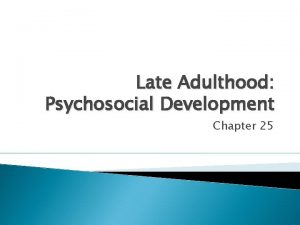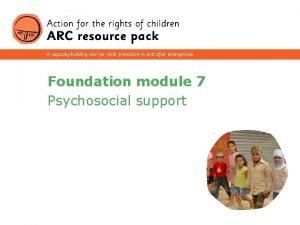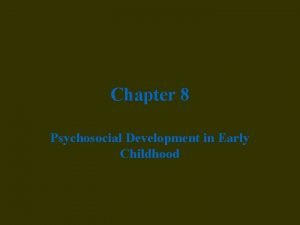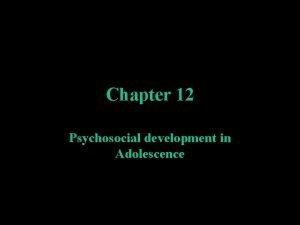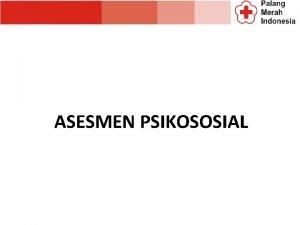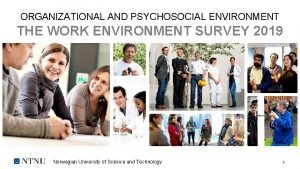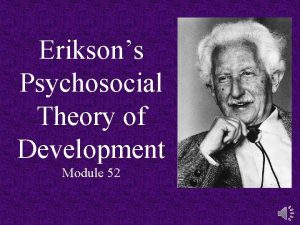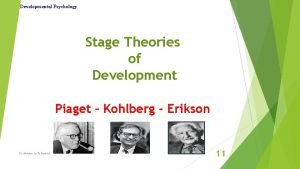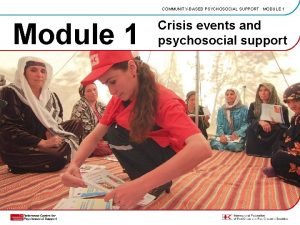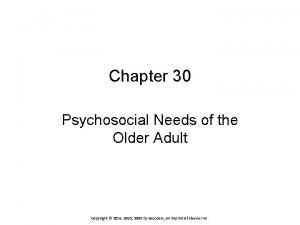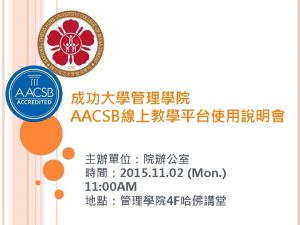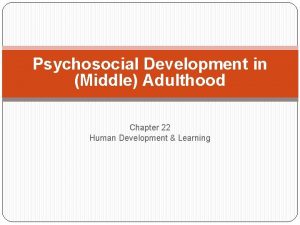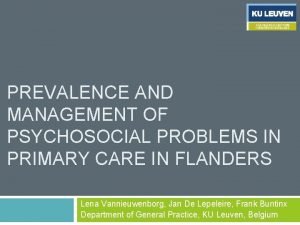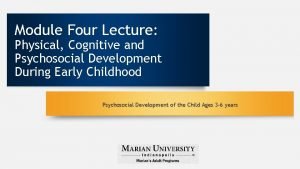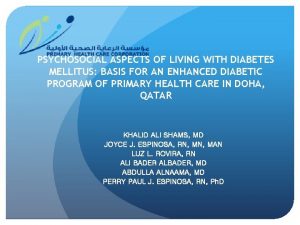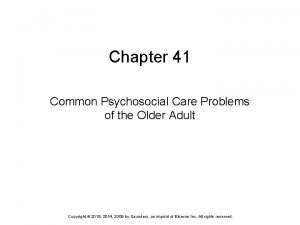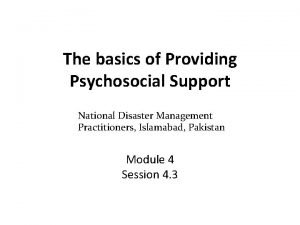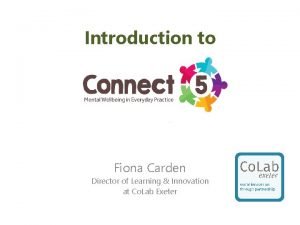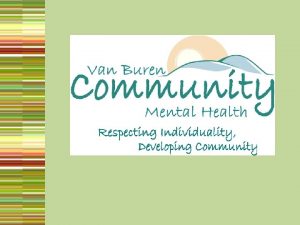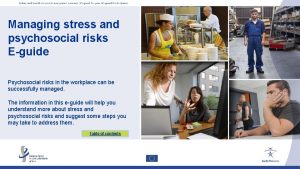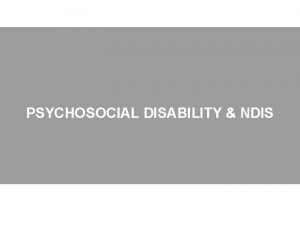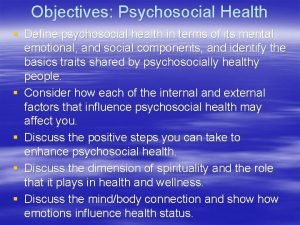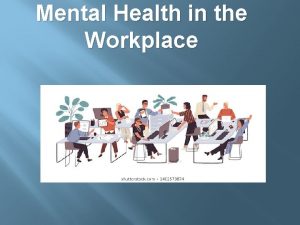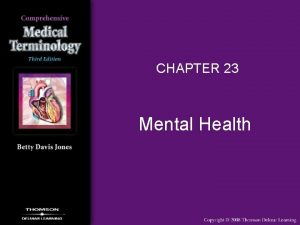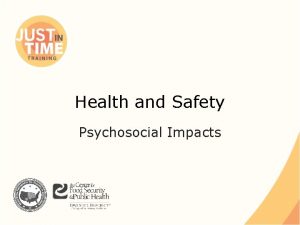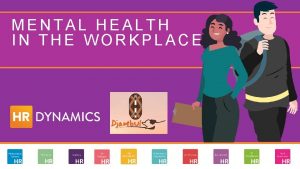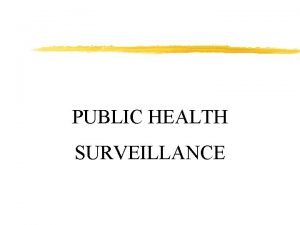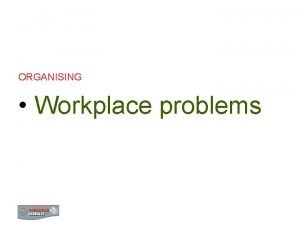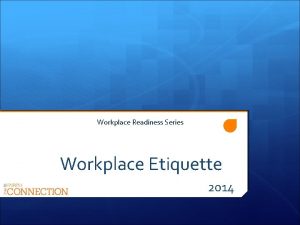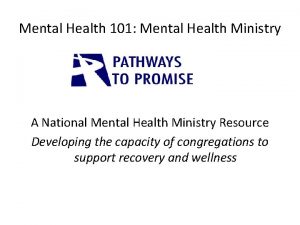Workplace psychosocial risks to mental health National surveillance





























































- Slides: 61

Workplace psychosocial risks to mental health: National surveillance and the Australian Workplace Barometer project Throwaway Workers And the revenge of the occupational health psychologists Occupational Health Society of Australia (WA Branch) Maureen Dollard maureen. dollard@unisa. edu. au Asia Pacific Centre for Work Health and Safety, University of South Australia

My argument • Psychological health at work is a serious occupational health and safety issue • Organisational factors are a powerful influence on the health of the person at work • A driving pressure is to improve productivity, and profitability- and accumulate capital and therefore • Dispensible (throwaway) workers are ok • We need resilient organisations for resilient people-psychosocial safety climate key maureen. dollard@unisa. edu. au

Outline • • • Cost of work stress Hierarchy of causes of worker health Psychosocial safety climate theory Results from Australia Workplace Barometer Resilient systems-resilient workers maureen. dollard@unisa. edu. au

Costs of Work stress • Significant risk factor for both physical (cardiovascular disease (CVD)) (Blekic, et al. , 2004) and • psychological health (e. g. , depression) (La. Montagne, Keegel, Vallance, Ostry & Wolfe, 2008). • Stress-related illnesses are forecast to be the leading causes of the global disease burden by 2020 (Murray & Lopez, 1996). • Related lost productivity costs to Australian employers around $14. 8 billion p. a. , or 1. 78% of GDP (Ecnotech, 2008). maureen. dollard@unisa. edu. au

$151 million per annum direct costs stress claims maureen. dollard@unisa. edu. au

Organisation of Work Influences on individual health and safety External Context Economic, legal, political, technological, and demographic forces at the national and international level • • Economic developments (eg globalisation of economy) Regulatory, trade, and economic policies (eg deregulation) Technological innovations (eg information/ computer technology) Changing worker demographics and labour supply (eg ageing population) Organisational Context Management structures, supervisory practices, production methods, and human resource policies • • • Organisational restructuring (eg downsizing) New quality & process management initiatives (eg high performance work systems) Alternative employment arrangements (eg contingent labour) Work/family/life programs and flexible work arrangements (eg telecommuting) Changes in benefits and compensation systems (eg gainsharing) Climate and culture Work Context Job characteristics • • Task attributes: temporal aspects, complexity, autonomy, physical and psychological demands Social-relational aspects of work Department of Health and Human Services (2002). The changing organisation of work and the safety and maureen. dollard@unisa. edu. au Worker roles health of working people. (Publication No. 2002– 116) Cincinnati, USA; The National Institute for Occupational Safety and Health (NIOSH). Career development

Forecast emerging organisational, social and human work related risks Changing labour markets Changing work organisations Impact on work characteristics Unstable labour markets, precarious contracts New forms of employment contracting practices Job insecurity Lean production, outsourcing Intensification of work, high work load, work pressure Globalisation Long working hours Changing workforce Ageing work force Poor work life balance maureen. dollard@unisa. edu. au Van den Bossche, S. , Smulders, P. , Houtman, I. Trends and risk groups in working conditions, TNO 2006 Impact on individuals Older workers

maureen. dollard@unisa. edu. au ©

What worker characteristics are required for these ‘dispossessed’ environments? • According to a managing director of an Australian call centre there are two types of people who make successful cold callers: extroverts and psychopaths • extroverts because they thrive on interactions with others, and • psychopaths because they are not emotionally hurt by constant rejection (Warne-Smith, 2006). • Should we select for these characteristics? • How are we to work in such environments? Warne-Smith, D. (2006). Confessions of a cold caller. The Weekend Australian Magazine, April 29 -30, 16 -20. maureen. dollard@unisa. edu. au

External Organisational Job design Individual Layers of influence on worker health maureen. dollard@unisa. edu. au

Community Demands • unemployment • public housing • nightclubs • income levels Policing R D Station D D Decision Making Station R Resources • Personnel Station maureen. dollard@unisa. edu. au D

Current Context Australian Productivity Commission 2010 Review of OHS • work-related stress and psychosocial hazards (e. g. work pressure, bullying and harassment) not given the same attention in OHS legislation and by OHS inspectors as physical hazards maureen. dollard@unisa. edu. au

Job Design Level maureen. dollard@unisa. edu. au

Work stress theories • Job Demands-Control model, Karasek, 1979 • Effort-Reward Imbalance model, Siegrist, 1996 • Job Demands-Resources model, (Demerouti, et 2001) • Job demands are things that have to be done • Job resources help get the job done maureen. dollard@unisa. edu. au

Job Demands-Resources Model Extended Health Erosion Path ? Demands Psychological Health Resources Engagement Extended Motivational Path maureen. dollard@unisa. edu. au

Towards a new theory Psychosocial Safety Climate Theory

Organisational Level maureen. dollard@unisa. edu. au

Psychosocial safety climate • Theories matter “not just because theories influence the institutional arrangements, norms, and language of organizational management, but also because theories focus both research and public policy attention” (Pfeffer, 2010, pg. 40).

PSC Defined • Psychosocial safety climate (PSC) refers to shared perceptions regarding policies, practices, and procedures for the protection of worker psychological health and safety • Look to PPP for evidence of organisations true priorities (Zohar) maureen. dollard@unisa. edu. au

rs cto a F l a n Exter Psychosocial safety climate Extended Health Erosion Path Psychosocial safety climate Demands Psychological Health Resources Engagement Extended Motivational Path Primary Prevention Secondary Intervention Tertiary Intervention Safety Outcomes • Accidents • Injuries • Errors Quality of Service Quality of Care

PSC Ingredients Management commitment 1. In my workplace senior management acts quickly to correct problems/issues that affect employees’ psychological health 2. Senior management acts decisively when a concern of an employees’ psychological status is raised 3. Senior management show support for stress prevention through involvement and commitment Priority 4. Psychological well-being of staff is a priority for this organization 5. Senior management clearly considers the psychological health of employees to be of great importance 6. Senior management considers employee psychological health to be as important as productivity Communication 7. There is good communication here about psychological safety issues which effect me 8. Information about workplace psychological well-being is always brought to my attention by my manager/supervisor 9. My contributions to resolving occupational health and safety concerns in the organization are listened to Participation and involvement 10. Participation and consultation in psychological health and safety occurs with employees’, unions and health and safety representatives in my workplace 11. Employees are encouraged to become involved in psychological safety and health matters maureen. dollard@unisa. edu. au 12. In my organization, the prevention of stress involves all levels of the organization

School study • School teachers, managers, supervisors, administration staff • 18 schools • PSC aggregated to school level • significantly negatively related to sickness absence maureen. dollard@unisa. edu. au


maureen. dollard@unisa. edu. au

Psychosocial Safety Climate T 1 Workload T 2 Emotional exhaustion T 2 Job control T 2 Psychological distress T 2 Supervisor support T 2 Between-groups Effects Sample T 1 (N = 202) Sample T 2 (N = 163) • Independent samples matched by work unit (N = 48) • Time 1 Time 2 24 months Main effects and mediation model maureen. dollard@unisa. edu. au ©

Police sample • Tests a three-way interaction • Demands X resources (in the context of PSC)

Study Design Study Model 1 Level 2 N = 23 stations PSC aggregated from all Time 1 (N = 319) Level 1 Time 1 and Time 2 matched Longitudinal -Stayers (N = 139) Demands T 1 Resources T 1 Distress T 1, T 2 Cross-validation Model 2 Level 2 N = 23 stations PSC aggregated from Time 1 Dropouts (N = 180) Level 1 Completely unrelated data Time 1 and Time 2 matched Longitudinal-Stayers (N = 139) Demands T 1 Resources T 1 Distress T 1, T 2


maureen. dollard@unisa. edu. au

PSC affects Interventions T

National Level maureen. dollard@unisa. edu. au

Australian Workplace Barometer project Maureen Dollard Anthony Winefield Work and Stress Research Group Centre for Applied Psychological Research, University of South Australia, Aust. Tony La. Montagne Mc. Caughey Centre: Vic. Health Centre for the Promotion of Mental Health & Community Wellbeing, School of Population Health, University of Melbourne, Australia Anne Taylor SA Health, Australia Arnold Bakker Erasmus University Rotterdam, The Netherlands Cameron Mustard & Peter Smith Institute for Work and Health, Toronto ARC Discovery Grant DP 0879007, maureen. dollard@unisa. edu. au ARC Linkage Grant, Safe. Work SA, and Safe. Work Australia

AUSTRALIAN WORKPACE BAROMETER • Launched February 2009 • World-class national survey aimed to identify psychosocial factors that impact on people’s wellbeing and effectiveness at work-identify at risk groups • To conduct the first longitudinal general population-based test of the PSC model of work stress and job engagement • Data collected from all sectors (private, government, nongovernment organisations) and professions in the Australian workforce

PUBLICATIONS Presentations and publications AWB book Safe Work Australia report Reports & enquiries

Australian Workplace Barometer • National surveillance project funded by Australian Research Council, Safe Work Australia and Safe. Work SA • Now across all Australian states and territories • Population based study • Over 10000 Computer assisted telephone interviews maureen. dollard@unisa. edu. au ©

*Depression costs Wes Mc. Ternan

Depression and costs to employer - Majority of the financial burden is caused by mild depression. - People with mild depression take 2 X as many sick days as people without depression. - People with severe depression take 5 X as many sick days. - Nearly 9% of the burden caused by two work factorsjob strain, bullying maureen. dollard@unisa. edu. au

PSC-12 Standards; PSC range 12 – 60 PSC 41 or above…Low risk PSC 37 or below. . High risk (35% of respondents)

20, 00 maureen. dollard@unisa. edu. au Wholesale trade Transport and storage Retail trade Property and business se. . . Personal and other servi. . . Mining Manufacturing Health and community s. . . Government administrat. . . Finance and insurance Electricity, gas and water. . . Education Cultural and recreational. . . Construction Communications services Agriculture, forestry and. . . Accommodation, cafes a. . . PSC By WA Industry 2014/2015 50, 00 45, 00 40, 00 35, 00 30, 00 25, 00

0, 00 maureen. dollard@unisa. edu. au Wholesale trade Transport and storage Retail trade Property and business se. . . Personal and other servi. . . Mining Manufacturing Health and community s. . . Government administrat. . . Finance and insurance Electricity, gas and water. . . Education Cultural and recreational. . . Construction Communications services Agriculture, forestry and. . . Accommodation, cafes a. . . Emotional Exhaustion By WA Industry 25, 00 20, 00 15, 00 10, 00 5, 00

PSC explained 9% of psychological health; 13% of variance in engagement. A 10% increase in PSC within organisations 4% decrease in demands, 5% decrease in bullying, 8% increase in resources, The-Australian-Workplace-Barometer-report 2012 3% reduction in psychological Dollard et al. problems, maureen. dollard@unisa. edu. au 4% (c) reduction in exhaustion, and 6 % increase in engagement.

maureen. dollard@unisa. edu. au © Work & Stress 2015

Bullying Time 1 2009/10 Management Commitment Time 1 Management Priority Time 1 Organisational Communication Time 1 Organisational Participation Time 1 Bullying Time 2 2011 Bullying Time 3 2014/2015 -. 254** -. 203** -. 134** -. 190** -. 153** -. 136** -. 161** -. 136** -. 100** -. 139** -. 194** -. 088** N = 1038 Australian workers maureen. dollard@unisa. edu. au

Australia 2014/2015 France Belgium Netherlands Austria Luxembourg Australia 2009/2011 Finland Ireland Latvia Slovenia Lithuania Germany United Kingdom Norway FYROM Malta Montenegro Greece Denmark Sweden Croatia Czech Republic Spain Portugal Albania Hungary Romania Cyprus Estonia Turkey Slovakia Kosovo Poland Bulgaria Italy 0, 00 9, 70 9, 37 9, 25 8, 88 7, 71 7, 37 7, 00 6, 88 5, 95 5, 68 5, 34 5, 30 5, 00 4, 77 4, 32 3, 58 3, 42 3, 27 3, 21 3, 16 2, 72 2, 64 2, 39 2, 30 2, 17 2, 03 1, 94 1, 83 1, 73 1, 52 1, 44 1, 23 0, 75 0, 68 0, 62 1, 00 2, 00 3, 00 4, 00 5, 00 % Employees 6, 00 7, 00 8, 00 9, 00 10, 00

2009 2010 2011 2014/2015 n to ry Te rri nd ns la ia or es 20 01 5 5 01 /2 /2 5 01 10, 7 14 14 20 5 5 5 01 /2 14 20 14 01 5 01 9, 9 rth er No ee Qu ct al W 20 5 5 01 /2 /2 14 14 20 20 /2 14 01 9, 7 Vi ut h T AC lia Au st ra lia 20 /2 1 5, 0 st ra Au an ia 14 01 9, 0 So n es te r sm 20 11 20 y 2 to r ia 10, 0 Ne w W lia ra st Au rri Te 15, 0 Ta th n 1 11 01 /2 20 7, 0 So u 10 an sm Ta 20 T 6, 6 er rth No lia ra st 11 20 10 20 6, 0 AC lia st ra lia 10 20 6, 0 Au st ra Au lia es 09 20 7, 0 Au ut h So ut h ra Au st al W es al W Bullying Percentage 7, 0 So rn th So u th lia ra Au st So u te es W Ne w rn te es W Australian States Bullying Rates 2009 -2015 15, 0 14, 0 10, 9 10, 1 9, 2 8, 0 7, 0 6, 0 4, 4 0, 0

International Level maureen. dollard@unisa. edu. au

maureen. dollard@unisa. edu. au ©

maureen. dollard@unisa. edu. au ©

Interim summary points • Workplace protection (national / organisational) important for worker health • Bullying rates high in Australia • Specific bullying procedures common for bullying in SA but only a small relationship to less bullying: (But bullying could be worse without procedures) (-. 12) • Psychosocial safety climate total (management commitment, priority, communication, participation) more strongly related to lower levels bullying (-. 24) • Better implementation and enactment of appropriate welltargeted procedures-good practice policies need to be accompanied by practical guidance and process/context facilitators (PSC) maureen. dollard@unisa. edu. au ©

Practical Level maureen. dollard@unisa. edu. au

PSC predicts future procedures and change in bullying/harassment Psychosocial Safety Climate T 1 2. 45*, 1. 01 2. 39**, . 76 Bullying/ Harassment Procedures T 2 -. 13**, . 04 Bullying/ Harassment Procedures T 3 -. 12*, . 05 Bullying/ Harassment T 2 Bullying/ Harassment T 1 Bullying/ ns. T 3 Harassment 1. 80**, . 39 . 44**, . 14 2010 -1. 36**, . 22 2011 All effects are between-group effects; Individuals T 1= 220, T 2= 152, T 3 = 94; Organisations T 1, T 2 = 30, T 3 = 27. 2014/2015

0, 25 Bullying 0, 2 0, 15 Control Low Actions 0, 1 High Actions 0, 05 0 Time 1 Time 2

PSC Hierarchy of Control (PSC HOC) Management Priority Senior management values: Organisational policy and procedure Worker ati icip art on on a l. P nic ati Or ga nis ati mu om l. C na tio isa Job design: Demands, controls, support, resources gan Bailey & Dollard, 2014 Leadership: Middle management implementation and supervisor support Or Management Commitment on Organisational development: Human resource management, injury prevention, injury management, OHS units





Organisational Resilience • Organisational resilience reflects the capacity of the organisation to cope with challenge, through flexible, adaptable and interactive systems, with psychosocial care. • Organisational resilience will be evident as better PSC, improved job design elements, improved employee health and resilience and improved work outcomes maureen. dollard@unisa. edu. au

Healthy Conducive Production Model Environment External resources, Expected, controllable Neg-Entropy Controller Management Political will Resources Union relations Surplus Organisation Neg-Entropy Social Level Controller Collective/ Management Neg-Entropy Conducive production Strong PSC Neg-Entropy External demands Random, Unexpected, Uncontrollable Neg-Entropy Spiral Sub- coordination possible Strong PSC maureen. dollard@unisa. edu. au Dollard & Karasek, 2008

Conclusion • Revision of the capitalist system • Resilience at work requires a resilient system that influences/sustains individual resilience • Psychosocial safety climate is an important component of a resilient organisational system • Interventions should aim to build resilient systems, and build psychosocial safety climate • Interventions at all levels –including national, state • National Surveillance -more frequently • Participation and ownership, Communication up and down • Matching resources to demands • All stakeholders involved especially union representation maureen. dollard@unisa. edu. au

Thank You Work & Stress Research Group Centre for Applied Psychological Research School of Psychology University of South Australia Contact maureen. dollard@unisa. edu. au
 Federal public service workplace mental health strategy
Federal public service workplace mental health strategy Federal public service workplace mental health strategy
Federal public service workplace mental health strategy Instant messaging security issues
Instant messaging security issues Workplace hazards and risks
Workplace hazards and risks Mental health and mental illness chapter 20
Mental health and mental illness chapter 20 Mental health jeopardy game
Mental health jeopardy game National mental health programme objectives
National mental health programme objectives National mental health programme
National mental health programme Conclusion of health and disease
Conclusion of health and disease Conclusion of health and disease
Conclusion of health and disease Regulatory agencies
Regulatory agencies Chapter 22 lesson 1 the health risks of drug use
Chapter 22 lesson 1 the health risks of drug use A thick, sticky, dark fluid produced when tobacco burns.
A thick, sticky, dark fluid produced when tobacco burns. Chapter 1 lesson 3 health risks and your behavior
Chapter 1 lesson 3 health risks and your behavior Related risks that increase in effect with each added risk
Related risks that increase in effect with each added risk Chapter 1 lesson 3 health risks and your behavior
Chapter 1 lesson 3 health risks and your behavior Health risks
Health risks Lifewave antenna
Lifewave antenna Chapter 20 lesson 2 choosing to live tobacco free
Chapter 20 lesson 2 choosing to live tobacco free National programme related to child health and welfare ppt
National programme related to child health and welfare ppt Workplace health without borders
Workplace health without borders Ict health and safety
Ict health and safety Erikson's psychosocial theory
Erikson's psychosocial theory Relaxation response technique
Relaxation response technique Psychosocial environment
Psychosocial environment Types of psychosocial support
Types of psychosocial support Psychosocial information
Psychosocial information Infancy psychosocial development
Infancy psychosocial development Emerging adulthood psychosocial development
Emerging adulthood psychosocial development Psychosocial tasks
Psychosocial tasks Late adulthood psychosocial development
Late adulthood psychosocial development 7 psychosocial support
7 psychosocial support Erikson's psychosocial crisis
Erikson's psychosocial crisis Integrity erikson
Integrity erikson Trust vs. mistrust
Trust vs. mistrust Psychosocial development in early childhood
Psychosocial development in early childhood Psychosocial development in adolescence
Psychosocial development in adolescence Test chapter 10 geriatric care
Test chapter 10 geriatric care Asesmen psikososial
Asesmen psikososial Types of psychosocial support
Types of psychosocial support Psychosocial and aesthetic factors
Psychosocial and aesthetic factors Psychosocial environment meaning
Psychosocial environment meaning Erickson's psychosocial theory of development
Erickson's psychosocial theory of development Mistrust vs trust
Mistrust vs trust Physical changes in adulthood
Physical changes in adulthood Erikson's psychosocial theory of development
Erikson's psychosocial theory of development Psychosocial module 1
Psychosocial module 1 Psychosocial needs of the elderly
Psychosocial needs of the elderly World association for psychosocial rehabilitation
World association for psychosocial rehabilitation Interdependence is a psychosocial concept
Interdependence is a psychosocial concept Middle adulthood psychosocial development
Middle adulthood psychosocial development Definition of psychosocial problems
Definition of psychosocial problems Define physical cognitive and psychosocial development
Define physical cognitive and psychosocial development Psychosocial aspects of living with diabetes
Psychosocial aspects of living with diabetes Common psychosocial care problems of the elderly
Common psychosocial care problems of the elderly Types of psychosocial support
Types of psychosocial support Psychosocial issues
Psychosocial issues Biopsychosocial model of health
Biopsychosocial model of health Mental sub factors national 5 pe
Mental sub factors national 5 pe Frankston ccu
Frankston ccu Lenawee community mental health authority
Lenawee community mental health authority Van buren cmh
Van buren cmh
